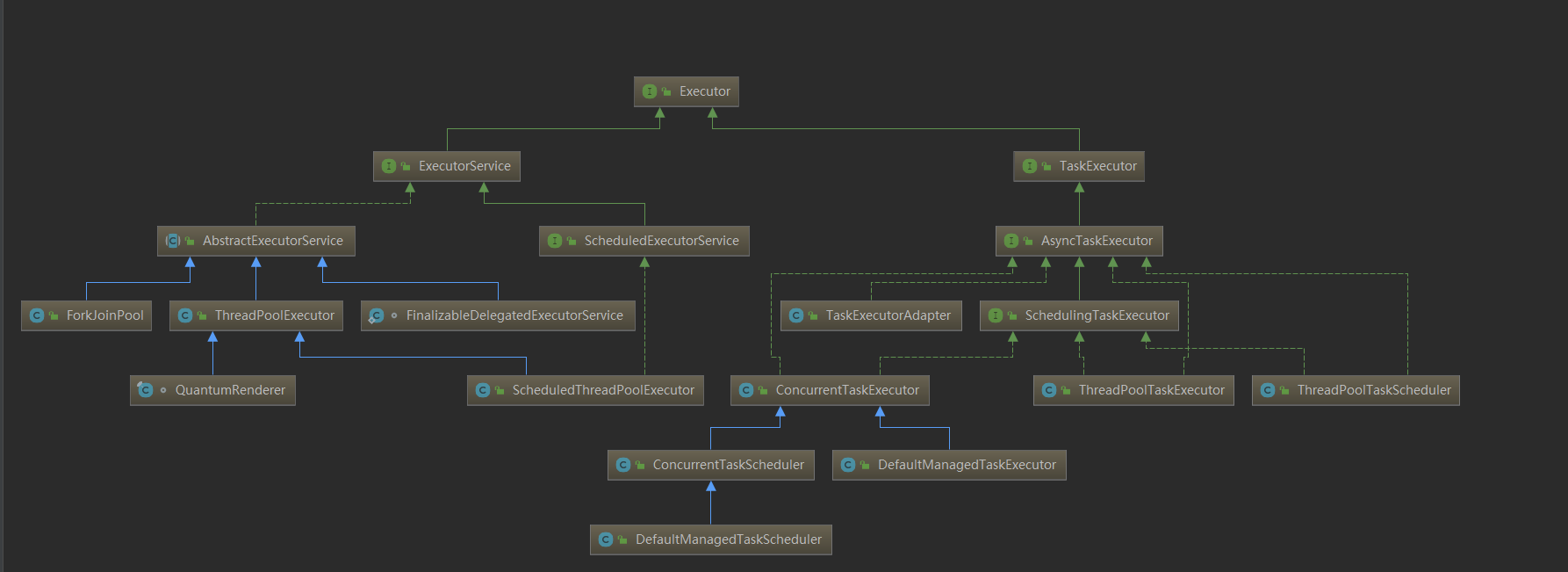说明:
线程共包括以下5种状态。
1. 新建状态(New) : 线程对象被创建后,就进入了新建状态。例如,Thread thread = new Thread()。
2. 就绪状态(Runnable): 也被称为“可执行状态”。线程对象被创建后,其它线程调用了该对象的start()方法,从而来启动该线程。例如,thread.start()。处于就绪状态的线程,随时可能被CPU调度执行。
3. 运行状态(Running) : 线程获取CPU权限进行执行。需要注意的是,线程只能从就绪状态进入到运行状态。
4. 阻塞状态(Blocked) : 阻塞状态是线程因为某种原因放弃CPU使用权,暂时停止运行。直到线程进入就绪状态,才有机会转到运行状态。阻塞的情况分三种:
(01) 等待阻塞 -- 通过调用线程的wait()方法,让线程等待某工作的完成。
(02) 同步阻塞 -- 线程在获取synchronized同步锁失败(因为锁被其它线程所占用),它会进入同步阻塞状态。
(03) 其他阻塞 -- 通过调用线程的sleep()或join()或发出了I/O请求时,线程会进入到阻塞状态。当sleep()状态超时、join()等待线程终止或者超时、或者I/O处理完毕时,线程重新转入就绪状态。
5. 死亡状态(Dead) : 线程执行完了或者因异常退出了run()方法,该线程结束生命周期。

线程池对象

1. 一个int类型的前三位实现线程池的状态变化
private final AtomicInteger ctl = new AtomicInteger(ctlOf(RUNNING, 0)); private static final int COUNT_BITS = Integer.SIZE - 3; private static final int CAPACITY = (1 << COUNT_BITS) - 1;
// runState is stored in the high-order bits private static final int RUNNING = -1 << COUNT_BITS; private static final int SHUTDOWN = 0 << COUNT_BITS; private static final int STOP = 1 << COUNT_BITS; private static final int TIDYING = 2 << COUNT_BITS; private static final int TERMINATED = 3 << COUNT_BITS;
// Packing and unpacking ctl private static int runStateOf(int c) { return c & ~CAPACITY; } private static int workerCountOf(int c) { return c & CAPACITY; } private static int ctlOf(int rs, int wc) { return rs | wc; }
2. 添加任务流程
/* * Proceed in 3 steps: * * 1. If fewer than corePoolSize threads are running, try to * start a new thread with the given command as its first * task. The call to addWorker atomically checks runState and * workerCount, and so prevents false alarms that would add * threads when it shouldn't, by returning false. * * 2. If a task can be successfully queued, then we still need * to double-check whether we should have added a thread * (because existing ones died since last checking) or that * the pool shut down since entry into this method. So we * recheck state and if necessary roll back the enqueuing if * stopped, or start a new thread if there are none. * * 3. If we cannot queue task, then we try to add a new * thread. If it fails, we know we are shut down or saturated * and so reject the task. */ int c = ctl.get(); if (workerCountOf(c) < corePoolSize) { if (addWorker(command, true)) return; c = ctl.get(); } if (isRunning(c) && workQueue.offer(command)) { int recheck = ctl.get(); if (! isRunning(recheck) && remove(command)) reject(command); else if (workerCountOf(recheck) == 0) addWorker(null, false); } else if (!addWorker(command, false)) reject(command);
3. addWorker 自旋设计使用retry
retry: for (;;) { int c = ctl.get(); int rs = runStateOf(c);
// Check if queue empty only if necessary.
if (rs >= SHUTDOWN &&
! (rs == SHUTDOWN &&
firstTask == null &&
! workQueue.isEmpty()))
return false;
for (;;) {
int wc = workerCountOf(c);
if (wc >= CAPACITY ||
wc >= (core ? corePoolSize : maximumPoolSize))
return false;
if (compareAndIncrementWorkerCount(c))
break retry;
c = ctl.get(); // Re-read ctl
if (runStateOf(c) != rs)
continue retry;
// else CAS failed due to workerCount change; retry inner loop
}
}






